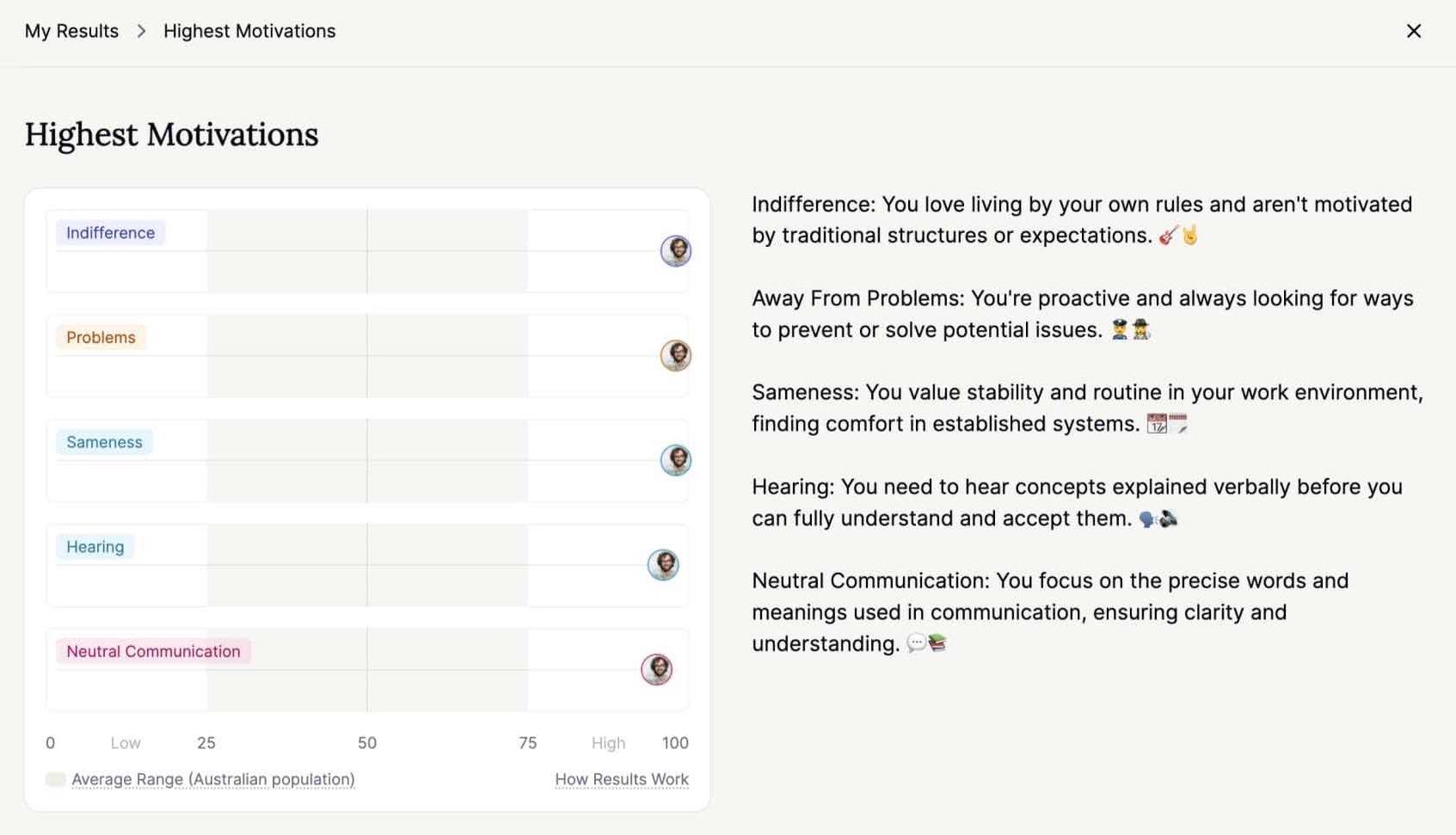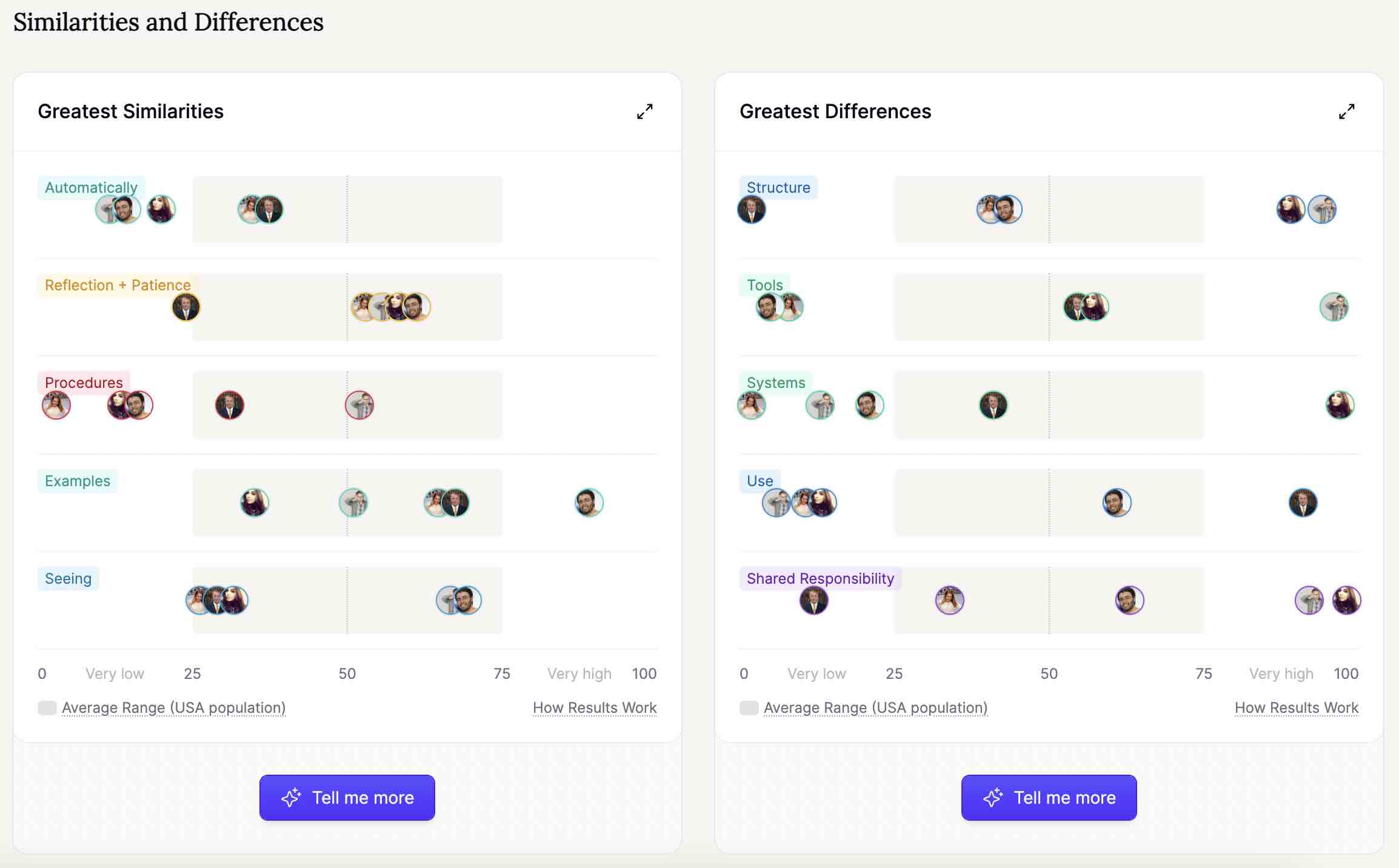How do you motivate your team? 9 Strategies for tough times
Motivating your team isn’t easy—especially in tough times or with challenging personalities. But the right approach changes everything. These 9 proven strategies will help you boost morale, drive engagement, and keep your team inspired when it matters most.
- Author
 William Haigen
William Haigen

The problem with "team motivation" and why it's so hard
It would be nice if motivating a team were as simple as following a recipe—toss in the right ingredients, mix well, and out comes a high-performing, fully engaged team. But the reality? Motivation doesn’t work that way.
Most advice on team motivation falls flat because it treats teams as a single entity, overlooking the fact that motivation is deeply personal. What fires up one team member might leave another completely unmoved. A cookie-cutter approach won’t cut it. That’s why today’s smartest leaders are ditching one-size-fits-all solutions in favor of evidence-based, tailored strategies.
Yes, uncovering what truly drives your team takes effort—but the payoff is undeniable. Leaders who crack the motivation code see game-changing results:
- A thriving workplace culture - When teams are motivated, engagement and morale skyrocket, creating a workplace where people feel valued, energized, and inspired.
- Stronger performance - It’s no surprise—motivated teams produce better results. When people feel connected to their work, productivity, creativity, and quality all go up.
- Fewer conflicts, more collaboration - Many workplace tensions stem from misunderstandings—especially when people’s communication styles, work preferences, and motivations clash. The key isn’t eliminating differences but learning to recognize, appreciate, and leverage them.
When leaders take the time to understand what drives each individual, they don’t just create a more motivated team—they build a culture where people thrive.
9 proven strategies to motivate your team—even in tough times
If you want to unlock your team’s full potential, motivation isn’t a nice to have—it’s a must. But keeping a team engaged, especially during challenging times or with diverse personalities, requires more than generic pep talks or performance bonuses.
The good news? Motivation isn’t a mystery. With the right approach, you can create an environment where your team feels inspired, valued, and ready to give their best. Here are nine science-backed strategies to help you do just that.
1. Discover what motivates your team
Trying to motivate a team without understanding what drives each person is like prescribing medicine without diagnosing the illness—you might get lucky, but chances are, it won’t work.
Many leaders assume recognition and praise are universal motivators. And while celebrating achievements is powerful for some, others are more energized by team collaboration, personal growth, or problem-solving. Marlee's groundbreaking Gen Z at Work Study revealed dramatic shifts in workplace motivations from Baby Boomers to Gen Z.
So, how do you get it right? Ditch the guesswork. Collaboration and performance technology like Marlee provide data-driven insights into your team’s unique work styles and motivators, allowing you to personalize how you give feedback, structure projects, and drive engagement. When motivation strategies are tailored to what actually matters to your team, you’ll see real results.

A Marlee Individual Results Board showing the highest motivators
2. Build a positive team culture (that drives results)
A common misconception in leadership is that a warm, supportive workplace comes at the expense of high performance. Some point to tough, high-pressure leadership styles in tech as the secret to success—but research tells a different story. Toxic cultures drive turnover rates 10.4 times higher than average,1 increasing burnout and lowering productivity. Meanwhile, companies that cultivate positive workplace cultures see higher engagement, creativity, and retention.2 As Sahil Lavingia puts it:3
Making something people want includes making a company that people want to work for.
So, what does a motivating workplace culture look like? For an employee driven by Affiliation and Group Environment, team outings, Friday drinks, and frequent check-ins may feel energizing. But, for someone who prefers autonomy, these same activities could feel like an unnecessary drain.
That’s why understanding what motivates each individual is key. With tools like Marlee, you can identify your team’s unique work style motivations and create a culture that genuinely inspires them—whether that means fostering collaboration, encouraging independent problem-solving, or something in between.
👉 Want to see how it works? Discover why Canva’s internal coaching team relies on Marlee to help everyone—from new hires to execs—grow, collaborate, and scale company culture.

A Marlee team Space showing similarities and differences in work styles
3. Foster collaboration
Collaboration isn’t just about working together—it’s about creating the right conditions for teamwork to thrive. Some employees are naturally energized by group dynamics, thriving on Affiliation, Shared Responsibility, and People motivations. For them, teamwork isn’t just a task; it’s a driver of engagement and performance.
But what about those who prefer independence or focus on results over relationships? Collaboration needs to be intentional and tailored—ensuring that team members can work together in ways that align with their natural strengths and motivations.
4. Set shared team goals
When teams rally around collective objectives, collaboration happens organically. Instead of just focusing on individual KPIs, set team-based milestones that create a sense of shared success.
5. Use the right tools
The best teams have seamless communication. Platforms like Slack, Asana, or Marlee for Zoom can streamline collaboration, making it easy for team members to stay aligned, regardless of their working preferences.
Here are our picks on the best project management and communication tools available:
6. Prioritize inclusion (because belonging fuels performance)
The highest-performing teams aren’t just collaborative—they trust each other. That trust starts with inclusion. When employees feel heard, valued, and respected, they engage more fully, contribute more openly, and drive better results.
But the cost of exclusion at work is real—and it goes far beyond hurt feelings. Research shows that when people feel left out, they’re not just demotivated; they’re more likely to engage in unethical behaviors like undermining colleagues, withholding information, or even cheating to protect their standing.3
As Marie Mitchell of the George Terry College of Business explains:
Individuals who fear that they are being excluded can often engage in behaviors that are pretty seedy. They undermine anybody outside that workgroup, they cheat to enhance their group’s performance level, they lie to other workgroups.
A culture of exclusion doesn’t just harm individual employees—it poisons trust across an entire organization.
7. Set clear goals that align with individual motivations
Goal-setting is a powerful motivator, but only when it reflects what truly drives each team member. While some employees are energized by Achieving Goals, others are more motivated by Solving Problems. Understanding these differences is key to keeping your team engaged.
How to tailor goal-setting to individual motivations
- For problem-solvers – Frame objectives as challenges to overcome rather than milestones to hit. These team members thrive when tackling inefficiencies, resolving obstacles, or improving processes.
- For goal-oriented team members – Set clear, measurable targets that create a sense of progress and accomplishment. These team members are energized by reaching milestones and seeing tangible results.
- Make goals SMART – No matter the motivation style, ensure goals are Specific, Measurable, Achievable, Relevant, and Time-Bound. If they feel vague or unrealistic, they can quickly become more discouraging than inspiring.
- Co-create goals – Instead of dictating targets, collaborate with your team to ensure each person’s role aligns with their natural motivation—whether that’s achieving a big win or solving a complex problem.
8. Adapt to different communication styles
Ever felt like you’re speaking a different language from a teammate? That disconnect often comes down to communication style. When people aren’t aware of these differences, it can lead to misunderstandings, frustration, and even conflict.
Marlee's research reveals two key communication styles:
- Affective Communicators – Expressive, emotive, and people-focused, they rely heavily on tone, body language, and storytelling. They thrive in conversational, high-energy discussions and are great at rallying enthusiasm.
- Neutral Communicators – More reserved and straight-to-the-point, they prefer logic, data, and efficiency. They stick to the facts and communicate in a concise, no-frills way—avoiding unnecessary embellishments.
Without an awareness of these styles, clashes can happen. An Affective Communicator might feel a Neutral Communicator is being cold or uninterested, while a Neutral Communicator might see an Affective Communicator as overly emotional or imprecise.
How to Bridge the Communication Gap
- Recognize and appreciate differences – Both styles have strengths. Affective Communicators bring energy and connection, while Neutral Communicators ensure clarity and precision.
- Adapt your approach – If you’re working with a Neutral Communicator, get to the point quickly. If you’re engaging an Affective Communicator, add warmth and storytelling.
- Leverage strengths in teamwork – Imagine a product pitch: the Affective Communicator drums up excitement with a compelling story, while the Neutral Communicator delivers clear, data-backed insights. Together, they create a powerful, balanced presentation.
By understanding and adapting to different communication styles, teams can avoid unnecessary friction and collaborate more effectively—turning potential miscommunication into a competitive advantage.
9. Foster personal development and professional growth
If you want a motivated, engaged team, make growth non-negotiable. People are most energized when they see a future for themselves—whether that’s mastering new skills, stepping into leadership, or expanding their expertise. Leaders who prioritize continuous development create a culture of momentum—where things happen, people grow, and opportunities feel within reach.
Beyond motivation, investing in personal and professional growth delivers game-changing benefits:
Why growth-driven cultures thrive
- A more skilled workforce – When learning is baked into the culture, your team stays ahead of the curve—bringing more innovation, efficiency, and expertise to their roles.
- Stronger succession planning – Developing internal talent ensures future leadership gaps are filled by people who already know and believe in your mission. This reduces knowledge loss and keeps institutional wisdom in-house.
- Higher employee well-being and satisfaction – Growth fuels confidence, job satisfaction, and happiness. Employees who see progress in their work lives are more engaged, resilient, and committed.
How to make growth a daily reality
- Make development accessible – Offer mentorship, online coaching programs, and self-paced learning that employees can engage with at their own speed.
- Personalize learning paths – Some thrive on technical mastery, others crave new challenges. Align growth opportunities with what motivates each individual.
- Recognize and reward growth – Celebrate skill-building, leadership milestones, and continuous improvement—not just big promotions. Small wins fuel long-term engagement—and even something as simple as personalized custom stress balls can be a thoughtful touch.
People don’t just want a job—they want progress, mastery, and purpose. When you make growth a priority, you don’t just build a stronger team—you create an environment where everyone wins.
Start unlocking your team's motivation
Motivating your team isn’t about quick fixes—it’s about understanding what drives each team member and creating a culture where they can thrive. From setting clear, personalized goals to fostering collaboration and growth, the right strategies boost engagement, performance, and trust.
Ready to build a more motivated, high-performing team? Start for free with Marlee—set up a Team Space today and unlock science-backed insights to empower every team member to do their best work.
Frequently asked questions
What is the best way to boost employee motivation levels?
The most effective way to boost employee motivation is by:
- Creating an appealing work environment
- Giving regular feedback
- Prioritizing employee well-being
- Offering development opportunities
Keep in mind there is no single formula to boost employee motivation or productivity levels. Employees are driven by different incentives, and are motivated by different things, and so what motivates one employee may demotivate another.
How to build a sense of camaraderie at work?
Leaders who foster a sense of camaraderie can raise morale and boost team motivation. Here are some critical steps to cultivating it:
- Create platforms for employees to share ideas and concerns
- Actively listen and respond to feedback
- Acknowledge and reward individual and team achievements.
What is the difference between intrinsic motivation and extrinsic motivation?
Intrinsic motivation stems from internal factors, such as personal enjoyment, a sense of accomplishment, or genuine interest in a task. Individuals driven by intrinsic motivation derive satisfaction and fulfillment from the work itself. Extrinsic motivation is derived from external rewards or consequences, such as praise, money, or recognition.
Employees motivated extrinsically may perform tasks to attain a specific outcome or avoid punishment.
When it comes to motivating a team, both types of motivation are needed. In challenging economic times, intrinsic team motivation alone isn't enough to motivate a team. Monetary rewards and career progression will often take precedence over the joy in the work itself.
What are the symptoms of low employee motivation?
If you suspect that employee motivation is low, here are some signs that you may be right.
Poor performance: Demotivated teams typically perform worse in their respective duties. They may miss deadlines, despite being given ample time, or produce lower quality work.
Decreased ambition levels: When employee motivation levels are low, they may be less likely to chase their career goals, or company goals. They may appear to be less driven overall, and may only do the bare minimum.
What leadership qualities help foster team motivation?
Strong leadership qualities play a pivotal role in team motivation. A leader's leadership style, characterized by empathy, clear communication, and vision, can inspire and energize their team. Effective leaders in a leadership role exhibit a genuine interest in their team's well-being and development.
References
1. Sull, D, 2022, Toxic Culture is Driving the Great Resignation, Available at: https://sloanreview.mit.edu/article/toxic-culture-is-driving-the-great-resignation
2. Iqbal, S, 2017, Effects of Job Organizational Culture, Benefits, Salary on Job Satisfaction Ultimately Affecting Employee Retention, Available at:
https://www.researchgate.net/profile/Shuja-Iqbal/publication/323084488_Effects_of_Job_Organizational_Culture_Benefits_Salary_on_Job_Satisfaction_Ultimately_Affecting_Employee_Retention/links/5cc1865f299bf120977da27c/Effects-of-Job-Organizational-Culture-Benefits-Salary-on-Job-Satisfaction-Ultimately-Affecting-Employee-Retention.pdf?_sg%5B0%5D=started_experiment_milestone&origin=journalDetail
3. Team Building, 2023, 58 Best Company Culture Quotes To Inspire Teams In 2023, Available at: https://teambuilding.com/blog/company-culture-quotes
4. Weeks, M, 2014, UGA study shows what happens when employees feel excluded at work, Available at: https://news.uga.edu/employee-exclusion-study/

